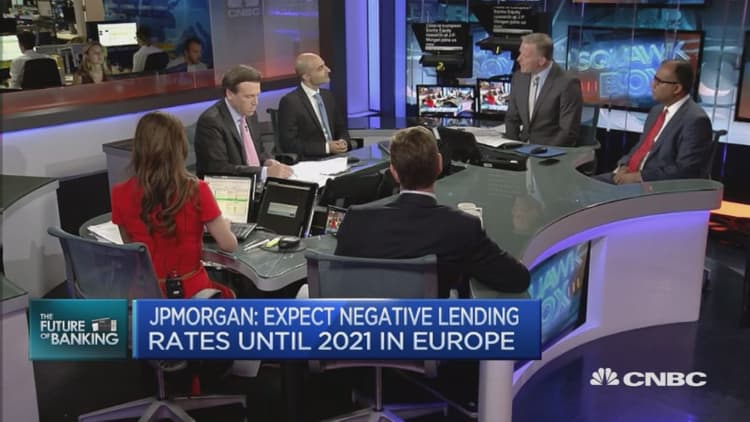
Equity valuations between Japanese and European banks will converge with quantitative easing (QE) programs and negative interest rate policies set to continue for the long term, according to a team at JPMorgan.
"QE reduces lending rates to negative and we are going to expect negative lending rates until 2021," Kian Abouhossein, head of European banks equity research at JPMorgan told CNBC Tuesday.
"So as long as that is the case, margins will not improve. Sixty percent of revenues is net interest income and as long as that's the case earnings will not improve. So return on equity is very low."
Balance sheet recession
European banks are more akin to their Japanese counterparts and less like Wall Street, warns JPMorgan, who has detailed how a negative interest rate policy has led to ongoing pressure on revenues and profit margins. Europe has seen a balance sheet recession since the economic crisis of 2008, it said, highlighting that a 10.9 percent increase in reserves at these banks has failed to increase lending to the wider economy.
"QE has worked initially and helped to stabilize asset prices, and to lower funding cost for banks …. However, the secondary long-term effects of QE are manifesting themselves in the form of pressure on revenues for European Banks with customer margins in euro area declining from 2.5 percent in 2011 to 1.8 percent in 2015," the report said.
The European Central Bank (ECB), the Danish National Bank (DNB), the Swedish Riksbank, and the Swiss National Bank (SNB) have all pushed key short-term policy rates into negative territory. A negative interest rate policy, or NIRP, essentially charges banks to hold cash at a central bank in the hope that they will instead lend to the real economy. Many expect banks to pass on this disincentive to save to its customers by trimming rates or by ramping up borrowing costs. The policy is increasingly being seen as a viable option for central bankers after Japan's move below zero earlier this year.
QE infinity
While this stimulates growth in some cases, negative rates put pressure on other sectors of the economy. A number of leading analysts have called for a balance of monetary and fiscal measures in order to slowly get the economy out of "QE infinity" – a paradox whereby low rates and seemingly endless rounds of bond-buying programs encourage cheap borrowing.
Alberto Gallo, head of macro strategies and manager of the Algebris Macro Credit Fund, told CNBC last week that for the global economy to exit this QE infinity trap, government action and reforms to improve productivity are needed.
"Many governments are reluctant to accept the need for these measures, often instead implementing policies that win votes but compound the distortions of easy monetary policy e.g. housing affordability programmes, mortgage subsidies," he said.
Without an adequate fiscal response from governments, growing imbalances make it harder to withdraw stimulus, warned Gallo.
The NPL problem
However, profit margins are not the only problems that banks in Europe are facing currently.
"There are two factors," Abouhossein told CNBC. "Operationally it is cost cutting and second is finding a price for non-performing loans. Non-performing loans need to come off the balance sheet. We have 700 billion euros($781 billion) of non-performing loans, half of that in southern Europe, 30 percent in Italy so we need to clean up."
Italian policymakers and European Union (EU) officials have been pondering how to improve Italy's fragile banking system in recent months, which has been bogged down by non-performing loans estimated to total around 360 billion euros ($401 billion).


